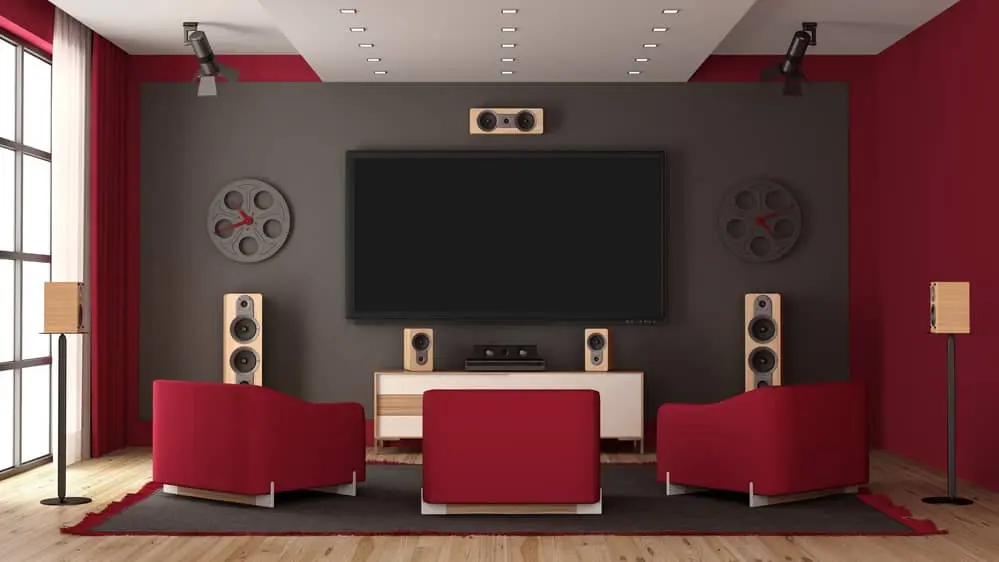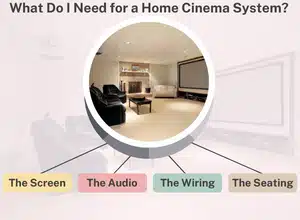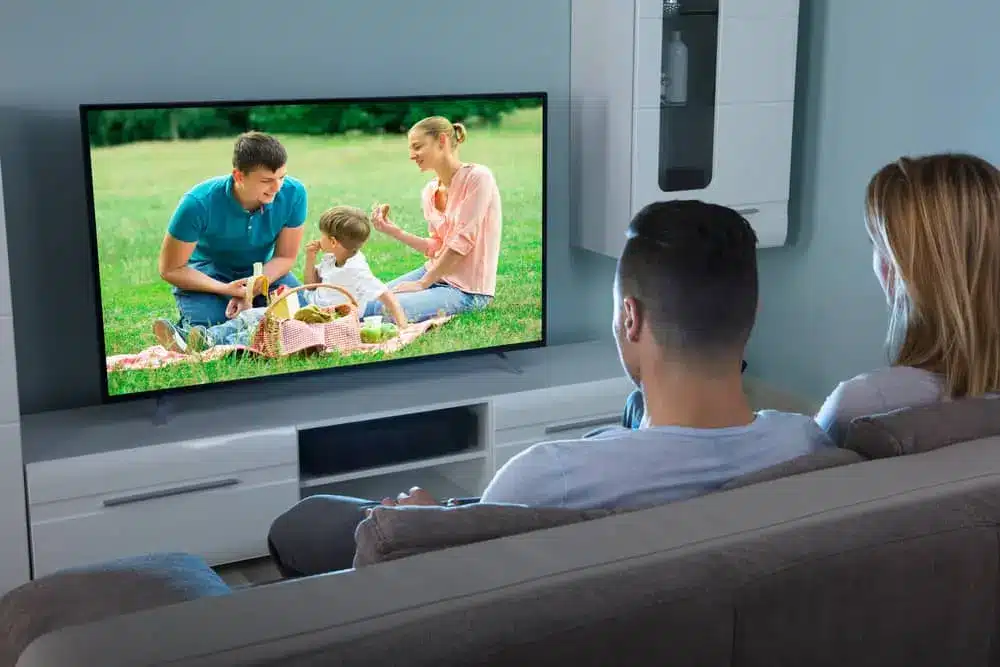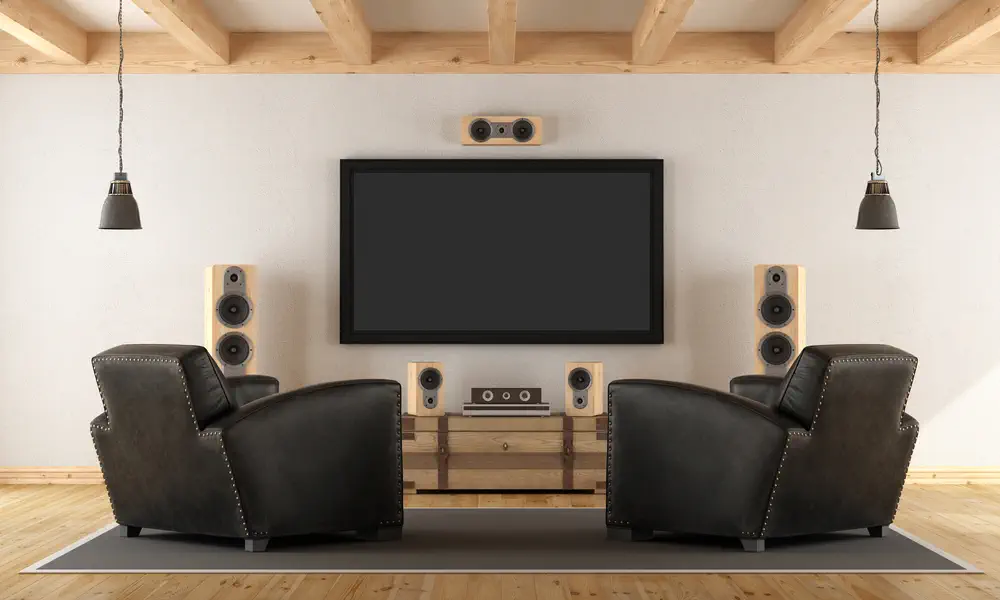Home cinema has always been the go-to system to improve and enhance a home’s entertainment system. As a modern homeowner who wants to enjoy movies and music after a long day at work or with the family, do you find yourself wondering, “What do I need for a home cinema system?” This article will break down all aspects of building the ultimate home cinema system setup. From how to choose a TV or screen and TV speakers to whether expensive wiring makes a difference to your home cinema experience, we’ve got you covered. Let’s dig in.
What Do I Need for a Home Cinema System?
The Screen
A home cinema without a screen is nothing more than a hi-fi with a Blu-Ray player, so in this section, we will focus on breaking down your best TV options.
It’s been over a decade since the first Full-HD TV screens hit the market, and during that period, some truly stunning 1080p TVs hit the market. Today, you can find a range of excellent Full-HD screens, but investing in one for your home cinema setup somewhat limits the future-proofing of your system.
4K, on the other hand, is a relatively new entrant to the home cinema world. With 4x the resolution of an 1800p display, 4K screens present unparalleled detail for your home cinema experience.

Outside of 4K, you’ll want to pay attention to some other standards. HDR (high dynamic range) has been touted as a potential game-changer for seeing content on our screens, thanks to its ability to display a greater range of colors than non-HDR sets. If you’re shopping for a new 4K display, you’ll find that most offer HDR image support.
Finally, we come to the issue of screen size. Is bigger better? What size TV do I need for the home cinema? Of course, it’s a matter of what your budget and room can take, but we’d advocate getting the largest screen you can. TVs smaller than 50 inches are ideal for a kitchen or bedroom. TVs from 50 to 65 inches are more fitting for the living room. And if you want to create a home cinema, 70-inch and up screens are the ideal choice. 4K content is only truly impressive when spread across a big screen; in terms of immersion, there’s nothing like a big screen to draw you in.
“How do I connect my home cinema to my TV?” you might ask. HDMI cables can be used for a receiver or amplifier setup with HDMI input ports. If your TV doesn’t have an HDMI output port, you can channel your sources (laptop, gaming console, set-top box) using an HDMI cable through to the receiver/amplifier or soundbar, then use a second HDMI cable from that device’s output port to your TV.
That way, you can use the receiver or soundbar’s remote control to switch between inputs, not the TV. You’ll still hear all the audio through the speaker setup used. This is handy if HDMI-ARC isn’t an option or if you want to play music on your receiver/amplifier-powered speakers without having your TV powered all the time.
The Audio
The cinema experience is about more than just pretty pictures; it’s about ultra-realistic, bone-shaking sound, too. In this regard, you’re not short of options, but there’s no one-size-fits-all approach to audio. So, we’re going to break down the advantages of various home cinema audio setups so you can figure out what’s best for you:
Soundbars – A soundbar is the simplest, often cheapest, way to improve your TV’s sound. Comprising a bar that sits in front of your TV, these systems significantly improve the weak, tinny audio that comes out of your TV. Depending on your soundbar choice, you can get ‘room-filling sound.’ Look out for those that include a subwoofer and BMR (Balanced Mode Radiator) technology, ensuring ultimate wide sound dispersion.

Soundbases – Often confused with soundbars, soundbases provide an alternative all-in-one audio solution. Instead of sitting in front of your TV like a soundbar, a sound sits underneath your TV stand, with the screen atop the speaker. These have the advantage of taking up less space than soundbars and often don’t require a separate subwoofer. However, they cannot be hung on a wall, making them less than ideal for those looking to wall-mount their television.
1 – 2.1 systems like Q Acoustics 7000i or M4 systems use a dedicated amplifier, a subwoofer, and two satellite speakers. This provides much improved audio quality over a soundbase or soundbar, which makes do with integrated speaker and amplifier units and creates a true stereo sound.
1 – Comprised of a central speaker for dialog, a pair of speakers to the left and right of your screen, and a pair just behind and to the left and right of your seating position, this is the basic surround sound system. When paired with a dedicated amplifier and properly configured, a 5.1 system like the Q Acoustics 3000i 5.1 can provide an incredibly immersive and deeply realistic sound for your home cinema, akin to that you’d get at a cinema.
1 – 7.1 systems came into being with the launch of HD-DVD and Blu-Ray, but they’ve since been widely adopted by home cinema enthusiasts who crave the most realistic sound profile. With seven speakers positioned to the front, side, and rear of your seating position, you’ll be treated to an incredibly immersive sound profile that draws you into your content.
Which of these you opt for will decide on the size and shape of your room, along with your budget. Naturally, the more speakers in your system, the greater the cinematic effect. However, there are superb options across the range. If you can, book an appointment to listen to your sound system before investing; that way, you’ll know what you’re getting.
Of course, you will need an amplifier with the 2.1 systems or above. Take your time to research which amplifier is best for your system. Each amplifier will have its benefits and output a certain amount of power. Once you’ve selected your speakers, consider what amplifier you need to power your system.
When doing this, consider whether your amplifier supports Dolby Atmos. Atmos is just finding its feet as a new standard, but it presents a league above surround systems as we’ve come to know and love. Atmos can process 128 simultaneous sound channels (compared to 8 for Dolby Digital 7.1) that can be sent to up to 64 speakers.
For a filmmaker, certain sounds can be targeted for specific speakers. For you at home, it means incredibly realistic audio. Atmos might be in its infancy at home, but with support from all the major studios, it’s quickly becoming an integral part of all serious home cinema setups.
Which Speaker is Best for Home Theater?

The choice of loudspeakers is very crucial for home cinema installations. They are at the end of the sound reproduction chain (source, amplifier, cable, speaker) and allow you to enjoy the quality of your Home Cinema multi-channel soundtracks (music, channels, surround effects…).
Most speakers have been developed to function in Stereo hi-fi and Home Cinema. Suppose you already have Hi-fi loudspeakers and wish to upgrade to a multi-channel configuration. In that case, we recommend using an effect, center, and bass loudspeaker from the same range. Loudspeakers from the same range often feature identical technologies and quite similar electronics. This is the best solution to ensure perfect timbre coherence and improved reproduction of effects or spatialization in the room.
The Seating
A home cinema setup has comfortable seating to take it all in. You can stomach an uncomfortable seat for a couple of hours at your local cinema but in your home. No way. When it comes to seating, though, it’s all about personal preference. However, our ultimate home cinema setup would have seats that didn’t sit high enough to block the sound from your speakers and could recline for increased comfort.
There are plenty of options for the dedicated home cinema fan, so whether you want soft-style recliners, custom multiplex-style seating, or even old-school theatre-style fold-up seats, there’s something for you.
The Wiring
In-home cinema, good quality cabling is an often-overlooked aspect, which is odd since it makes such a huge difference to the audio-visual fidelity of your system. It’s always worth investing in a high-quality HDMI cable.

Ensuring your HDMI cable conforms to the latest High-Speed HDMI 2.0 standard, designed to support things like 4K at 60fps and HDR video, is essential, as it can unlock the best of your home cinema’s potential.
You should also pay keen attention to your speaker cable. The pre-packaged speaker cables with your speakers will do the job in a pinch, but you’ll sell your equipment short with cheap cable. Instead, invest in a higher quality cable and reveal the detail in your sound system.
We’re Here to Help!
A professional hand sets a dedicated home theater experience apart from watching a movie on the TV in your living room. Professional calibration of your AV installation ensures you receive the best audio and video performance from your equipment. Our techs can calibrate video display settings for optimal color, contrast, and brightness. We’ll add acoustic treatments to minimize ambient noise and deliver balanced, even sound to every seat.

